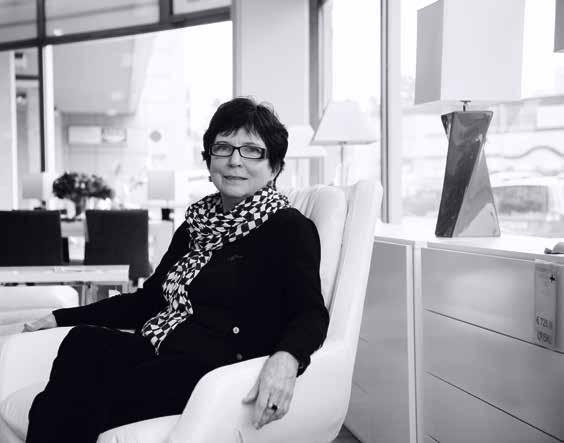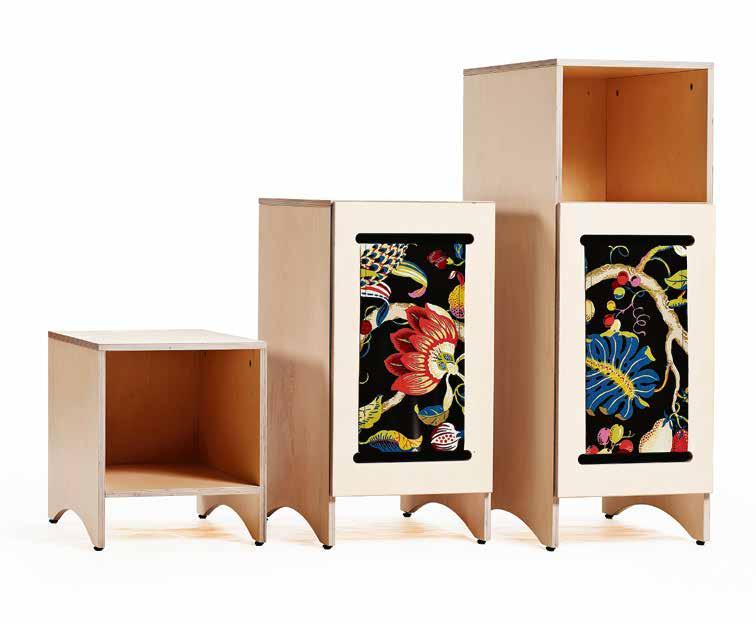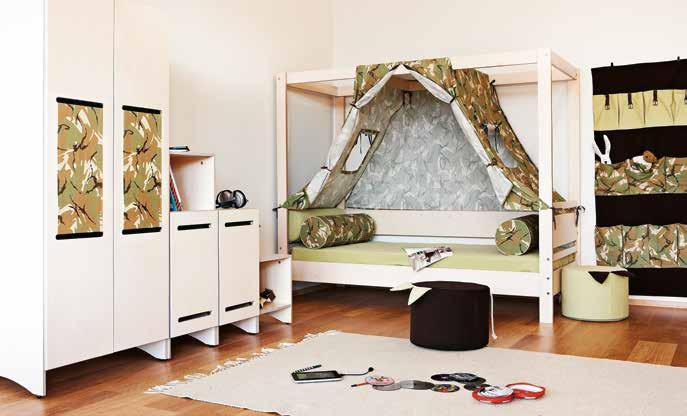
5 minute read
LASTE- jA nOORTEMööBEL MURUUM
from RUUMIPILT 2012
Anu Vainomäe on lõpetanud Eesti Kunstiakadeemia sisearhitektina. Välisministeeriumis töötades valmisid Eesti Vabariigi suursaatkondade ja esinduste kujundused Tel-avivis, Pariisis, ankaras, brüsselis, Prahas, budapestis, Haagis. on esinenud näitustel ja messidel, teinud tootedisaini firmadele Hapval ja NCS Möbler ab. Tänaseks peab oma sisearhitektibürood.
Anu Vainomäe has graduated with honours from the Estonian Academy of Arts as an interior architect. While working for the Ministry of Foreign Affairs, she completed the designs for embassies and diplomatic missions of the Republic of Estonia in Tel-Aviv, Paris, Ankara, Brussels, Prague, Budapest and The Hague. She has participated in exhibitions and fairs, and designed products for the companies Hapval and NCS Möbler AB. Nowadays she runs her own interior architecture bureau.
Advertisement
www.muruum.ee
MuruuM furniturE for childrEn and young pEoplE
autor/author:
fotod/photos:
Anu Vainomäe
Sille Parik
lastele ja noortele suunatud mööbli teema on Eesti disainis viimastel aastatel tihti käsitlemist leidnud: sixten heidmets ja sirli põllumäe, igor volkov, pavel sidorenko. Kõigile neile on vineer südamelähedane materjal. Muruumi sari on selles võrdluses asjalik, rahulik, kindlapeale toimiv. võib-olla isegi liiga „tavaline”. Katse selles vallas maailma parandada on teretulnud. oma isikupära juurde lisades õnnestub ilmselt mööbel tõeliselt „kodustada”.

Kaido Kivi, sisearhitekt ja ESLi aastapreemiate žürii esimees

Mööbli disain ja tootmine on kaks eri asja, siinkohal on need aga sujuvalt üheks saanud. Tegu on välisturgudele laieneva uudse kaubamärgiga, mis on fokusseerinud oma tegevuse kõige noorematele. Huvitav, kas 21. sajandil on laps võrreldes möödanikuga oma soovide ja vajaduste poolest erinev?
Mis on selle mööbliseeria tekkelugu ja kuidas see kõik alguse sai? Anu Vainomäe (AV): Muruum sündis, sest Eesti turul puudus arvestatav lastemööbel. Pakuti vaid männipuust pisikest ja pikendatavat, laminaadist roosat või helesinist mööblit, mis ei sobi tänapäevase arhitektuuriga. Koos Sille Parikuga, selle töö tellijaga, kellele olin varem sisekujunduslahenduse teinud, hakkasime ideed teoks tegema. Tänaseks on kogu seeria tootmises ning jõuab tellijateni nelja nädalaga.
Seadsid ise endale lähteülesande. AV: See mööbel siin, kus on kapid ja lauad ja lisandid, peaks moodustama terviku, mis on loodussõbralik, lihtsalt muudetav, pikaealine ning väga hea kvaliteediga, mõnus käe all katsuda. Lapse kasvades saab detaile lisades, eemaldades ja vahetades mööblit lapse vajadustega sobitada ning ühest legendist saab teise, teisest kolmanda... Vaheta tekstiile ja sul on uus elu! olles ülikoolini välja jõudnud, saab omad lapsed sinna askeldama panna, näiteks. Vineeriga ei juhtu midagi, see on mõnes mõttes ajatu.
Mis sind inspireeris, kui mingeid piire ees ei olnud? AV: Kaske olen ma armastanud, ilmselt on eestlased seda üldse armastanud. See on vastupidav ja vineer on alati väga inspireeriv, minu jaoks vähemalt. Kasevineeril on tohutult eri ilmeid, kasutades erinevaid peitsitoone, loome lahendusi nii poistele kui tüdrukutele, nii romantilisema kui modernistlikuma joonega.
Milline on ruumi ja mööbli omavaheline suhe – kui suur peaks lapse tuba olema? AV: Eramus on rohkem ruumi, aga see mööbel sobib hästi ka mõnikümmend aastat tagasi valminud lastetuppa. Tegelikult võiks tuba suurem olla, kui nad projektides tavaliselt on, taandatuna 10-11 ruutmeetri peale. Mida suurem tuba, seda vahvam, sest lastele meeldib koos mängida. Laps vajab ruumi ka omaette olemiseks. Meie nari võimaldab seda vaatamata ruumikitsikusele.
Kas hinna ja kvaliteedi suhe on ka Eesti inimesele vastuvõetav? AV: Meie lahendus on säästlik ja kestab vaid tekstiile vahetades lapseeast täiseani – see on ühekordne investeering. Lastelgi peaks olema korralik ümbrus, kui ehitatakse endale korralikku kodu.
Kui vaadata neid mudeleid, siis ega 21. sajandi laps väga teistmoodi ei ole? AV: Tänapäeva lapsed on küll allergilisemad, aga mängitakse ikka täpselt samamoodi – minu lapsed tahtsid ikka oma pesa, ehitada telke ja urge või mängida nukuteatrit.


The theme of furniture for children and young people has been considered often in Estonian design in recent years: Sixten Heidmets and Sirli Põllumäe, Igor Volkov, Pavel Sidorenko. Plywood is a material that they all cherish. The MURUUM line is practical, mellow and reliably functional in this comparison. Perhaps it is even too “ordinary”. Attempts to reform the world in this field are welcome. This furniture really can probably be successfully “domesticated” by adding one’s own personal touch.
Kaido Kivi, interior architect and chairman of the ESL annual awards jury
Furniture design and production are two different things, yet here they are smoothly combined into one. This is a novel trademark that is expanding into foreign markets and focuses on products for young children. I wonder, are children in the 21st century with their wants and needs any different compared to the past?
How did this furniture line come about and where did it all start? Anu Vainomäe (AV): MURUUM was born because the Estonian market lacked quality children’s furniture. The market offered only tiny and extendable pinewood furniture, and pink or light blue laminated furniture that doesn’t suit today’s architecture. We started putting our ideas in practice together with Sille Parik, the customer for this furniture for whom I had previously designed interiors. The entire line is in production by now and reaches the customer in four weeks.
You set your initial task yourself. AV: This furniture here with cupboards, tables and accessories should form a whole that is ecological, durable, high quality, and can be easily converted. It’s pleasant to touch. The furniture can be adjusted to the child’s needs as he grows by adding, removing and replacing details. One legend turns into a second, the second turns into a third…Replace the textiles and you have a new life! When you reach university, you can let your own children bustle about there, for instance. Nothing happens to plywood, it’s timeless in a sense.
What inspired you if you had no restrictions? AV: I have always loved birch wood. Estonians on the whole have probably loved it. It’s durable and plywood is always very inspiring, at least for me. Birch plywood has vastly differing appearances. We create products for boys and girls using different tones of stain for more romantic or more modern styles.
What is the relation between the furniture and the room it is in – how large should the child’s room be? AV: There is more space in a private dwelling but this furniture is also well suited for children’s rooms completed a couple of decades ago. The room should actually be bigger than they usually are in design projects, reduced to 10-11 square metres. The larger the room, the better because children like to play together. Children need room to be on their own. Our bunk bed makes this possible regardless of lack of space.
Is the ratio between price and quality acceptable for Estonians as well? AV: Our furniture is economical and lasts from childhood to adulthood with only the need to replace the textiles – this is a one-time investment. Children should have proper surroundings when people build proper homes for themselves.
If you look at these models, it doesn’t appear as if 21st century children are much different? AV: Today’s children are more allergic but they still play exactly the same way – my children still wanted their own nest, to build tents and burrows, or to play puppet theatre.









